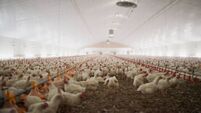How best to relieve shortages of fodder
Normally, farmers would have to wait until August 31 to harvest fodder grown on set-aside land. Sale of fodder from these lands is, however, still not allowed.
The measure may bring some relief after dry weather has reduced growth rate by at least 25% in most areas outside the north and west, and brought a complete halt to growth in the southeast, due to that region’s 70mm-plus moisture deficits.
With 3-4mm of moisture evaporated from soils in fine weather, a lot of rainfall is needed to help the many farmers who are very short of grazing grass, and, in many cases, winter feed.
Teagasc advisors say winter feed shortages can be tackled by shortening the winter, buying meals, silage (grass, wholecrop or maize), buying hay or straw; growing forage crops (such as rape) or Westerwolds, providing winterage (built up grass) for deferred grazing or selling cattle or cull cows.
Citrus pulp forward bought at €115 per tonne (pay now, deliver later) is recommended as good value for money.
Meanwhile, dairy farmers have been advised to try to maintain a 22-day grazing rotation, by supplementing grass with extra feed.
At a stocking rate of 2.5 cows per hectare, with a growth rate of 30kg of dry matter per hectare per day, 5kg of dry matter (5.75kg of fresh concentrate feed) must be fed to maintain milk yield, body condition and grazing rotation.
Dairy cows should also have access to their requirement of 90 litres per day (they will drink up to 14 litres per minute) within 200 metres of where they graze.
Cattle generally will drink 10 to 15 litres per 100 kg of body weight.
Zero grazed grass from an outside farm is being fed by some farmers with 3-4kg of citrus pulp.
Farmers are advised to continue recommended levels of nitrogen fertilisation, but if no growth occurred since the last application, to stop spreading until rain comes.
In many situations, farmers will have to scrap autumn reseeding plans.













